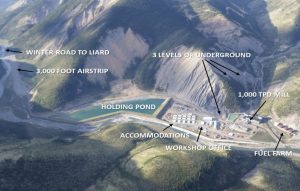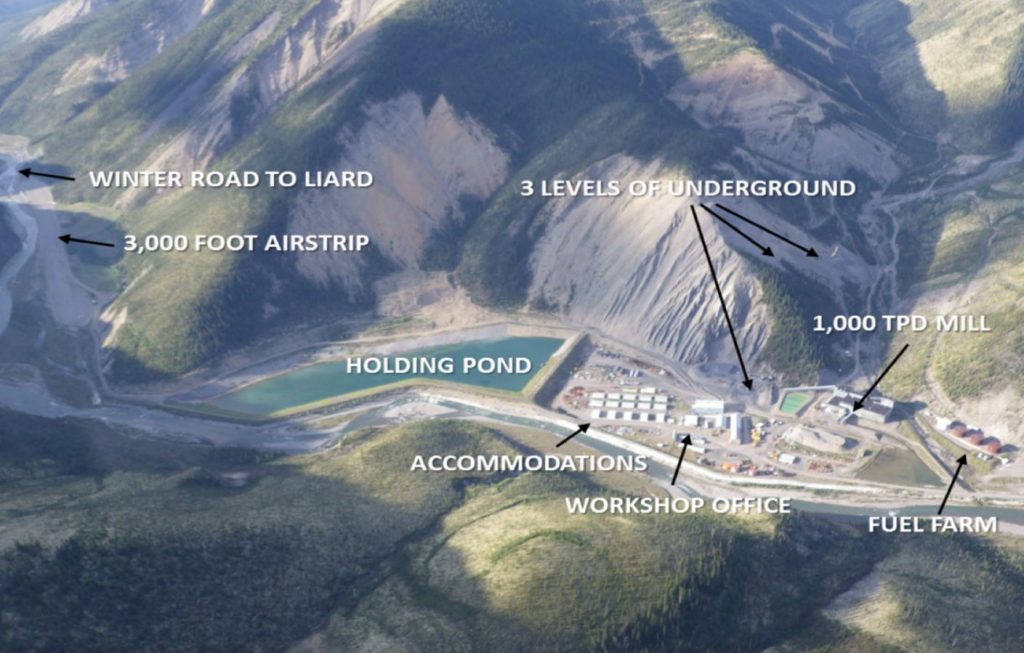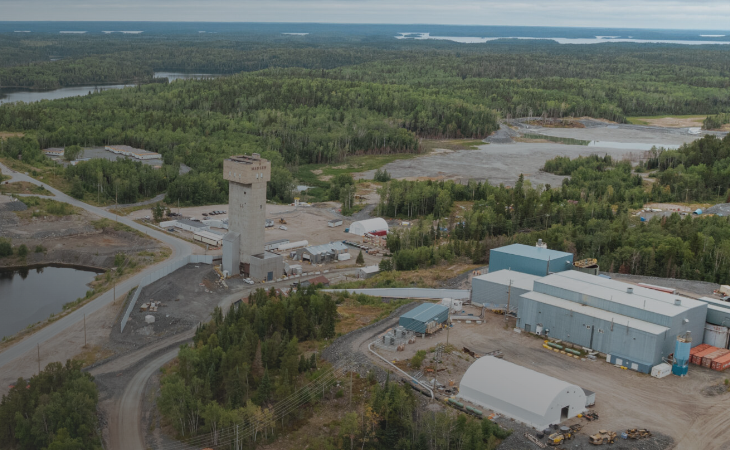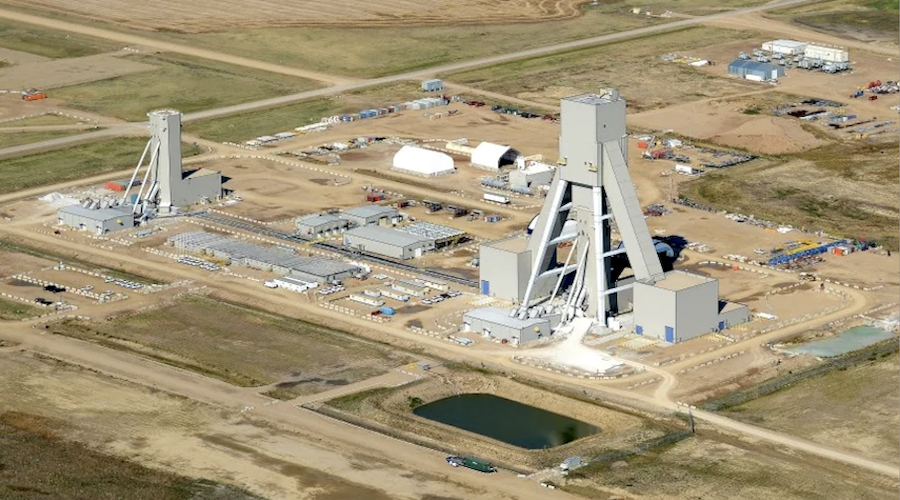[caption id="attachment_1003724783" align="aligncenter" width="479"]
 General layout of the infrastructure at the Prairie Creek zinc project. (Image: NorZinc Ltd.)
General layout of the infrastructure at the Prairie Creek zinc project. (Image: NorZinc Ltd.)[/caption]
VANCOUVER –
NorZinc Ltd. has changed its name from
Canadian Zinc Corp. and will trade on the TSX under the new symbol NZC. The new name is part of a rebranding initiative that will draw attention to the company’s core business –zinc, lead and silver mining focused in Canada’s north.
NorZinc’s flagship asset is the Prairie Creek underground zinc-lead-silver mine and mill 200 km west of Fort Simpson in the Northwest Territories.
The property may hold the title of the slowest development ever – more than 50 years and counting. Discovered in 1928, it was not until the last half of the 1960s that modern exploration was begun by Penarroya Canada. From 1970 to 1980 significant underground development of zone 3 was done on two levels.
In 1980 a feasibility study was conducted for Procan Exploration, a private company owned by Nelson Bunker Hunt and his brother William Hunt of Texas. Readers with long memories may remember the Hunt brothers’ attempt to corner the world’s silver markets. But like all artificial market manipulations, after the silver price ran up to about $50 an ounce it dropped like a rock, taking hopes for the Prairie Creek mine with it in 1982.
The property was tied up in litigation until 1990. About $64 million had been spent up to that time. The surface facilities were 90% to 95% complete. The mill was ready to treat 500 t/d of feed, and the mine was prepared to supply it.
In 1991 then-owner Conwest Exploration granted an option to Canadian Zinc (then known as San Andreas Resources). The following year Canadian Zinc discovered stratabound mineralization in the Main zone, opening up the prospects for expanding the resource. By 2001 Canadian Zinc completed an environmental assessment, metallurgical tests, diamond drilling, a co-operation agreement with the Nahanni Butte Dene Band. Then the permitting process was undertaken between 2003 and 2005 and Prairie Creek was granted a land use permit and water licence.
Canadian Zinc doggedly moved the project forward through additional environmental assessment, revision of its licences, rehabilitation, and extensive exploration. Finally in 2012, the company completed a positive preliminary feasibility study. The permitting process crept along, resulting in the delivery of a revised land use permit and type A water licence in 2013. Offtake agreements with Korea Zinc and Boliden were signed in 2016.
The bankable feasibility study was completed in 2017 for a project with a $279-million capex, a mining rate of 1,600 t/d, a milling rate of 1,200 t/d, and increased reserves. The proven and probable reserve now stands at 8.1 million tonnes grading 8.10% lead, 8.17% zinc, and 124.22 g/t silver.
With a fresh new name, this may be NorZinc’s opportunity to reach commercial production.
Until the new website can be built to match the new name, find more information about Prairie Creek at
www.CanadianZinc.com.

 General layout of the infrastructure at the Prairie Creek zinc project. (Image: NorZinc Ltd.)[/caption]
VANCOUVER – NorZinc Ltd. has changed its name from Canadian Zinc Corp. and will trade on the TSX under the new symbol NZC. The new name is part of a rebranding initiative that will draw attention to the company’s core business –zinc, lead and silver mining focused in Canada’s north.
NorZinc’s flagship asset is the Prairie Creek underground zinc-lead-silver mine and mill 200 km west of Fort Simpson in the Northwest Territories.
The property may hold the title of the slowest development ever – more than 50 years and counting. Discovered in 1928, it was not until the last half of the 1960s that modern exploration was begun by Penarroya Canada. From 1970 to 1980 significant underground development of zone 3 was done on two levels.
In 1980 a feasibility study was conducted for Procan Exploration, a private company owned by Nelson Bunker Hunt and his brother William Hunt of Texas. Readers with long memories may remember the Hunt brothers’ attempt to corner the world’s silver markets. But like all artificial market manipulations, after the silver price ran up to about $50 an ounce it dropped like a rock, taking hopes for the Prairie Creek mine with it in 1982.
The property was tied up in litigation until 1990. About $64 million had been spent up to that time. The surface facilities were 90% to 95% complete. The mill was ready to treat 500 t/d of feed, and the mine was prepared to supply it.
In 1991 then-owner Conwest Exploration granted an option to Canadian Zinc (then known as San Andreas Resources). The following year Canadian Zinc discovered stratabound mineralization in the Main zone, opening up the prospects for expanding the resource. By 2001 Canadian Zinc completed an environmental assessment, metallurgical tests, diamond drilling, a co-operation agreement with the Nahanni Butte Dene Band. Then the permitting process was undertaken between 2003 and 2005 and Prairie Creek was granted a land use permit and water licence.
Canadian Zinc doggedly moved the project forward through additional environmental assessment, revision of its licences, rehabilitation, and extensive exploration. Finally in 2012, the company completed a positive preliminary feasibility study. The permitting process crept along, resulting in the delivery of a revised land use permit and type A water licence in 2013. Offtake agreements with Korea Zinc and Boliden were signed in 2016.
The bankable feasibility study was completed in 2017 for a project with a $279-million capex, a mining rate of 1,600 t/d, a milling rate of 1,200 t/d, and increased reserves. The proven and probable reserve now stands at 8.1 million tonnes grading 8.10% lead, 8.17% zinc, and 124.22 g/t silver.
With a fresh new name, this may be NorZinc’s opportunity to reach commercial production.
Until the new website can be built to match the new name, find more information about Prairie Creek at
General layout of the infrastructure at the Prairie Creek zinc project. (Image: NorZinc Ltd.)[/caption]
VANCOUVER – NorZinc Ltd. has changed its name from Canadian Zinc Corp. and will trade on the TSX under the new symbol NZC. The new name is part of a rebranding initiative that will draw attention to the company’s core business –zinc, lead and silver mining focused in Canada’s north.
NorZinc’s flagship asset is the Prairie Creek underground zinc-lead-silver mine and mill 200 km west of Fort Simpson in the Northwest Territories.
The property may hold the title of the slowest development ever – more than 50 years and counting. Discovered in 1928, it was not until the last half of the 1960s that modern exploration was begun by Penarroya Canada. From 1970 to 1980 significant underground development of zone 3 was done on two levels.
In 1980 a feasibility study was conducted for Procan Exploration, a private company owned by Nelson Bunker Hunt and his brother William Hunt of Texas. Readers with long memories may remember the Hunt brothers’ attempt to corner the world’s silver markets. But like all artificial market manipulations, after the silver price ran up to about $50 an ounce it dropped like a rock, taking hopes for the Prairie Creek mine with it in 1982.
The property was tied up in litigation until 1990. About $64 million had been spent up to that time. The surface facilities were 90% to 95% complete. The mill was ready to treat 500 t/d of feed, and the mine was prepared to supply it.
In 1991 then-owner Conwest Exploration granted an option to Canadian Zinc (then known as San Andreas Resources). The following year Canadian Zinc discovered stratabound mineralization in the Main zone, opening up the prospects for expanding the resource. By 2001 Canadian Zinc completed an environmental assessment, metallurgical tests, diamond drilling, a co-operation agreement with the Nahanni Butte Dene Band. Then the permitting process was undertaken between 2003 and 2005 and Prairie Creek was granted a land use permit and water licence.
Canadian Zinc doggedly moved the project forward through additional environmental assessment, revision of its licences, rehabilitation, and extensive exploration. Finally in 2012, the company completed a positive preliminary feasibility study. The permitting process crept along, resulting in the delivery of a revised land use permit and type A water licence in 2013. Offtake agreements with Korea Zinc and Boliden were signed in 2016.
The bankable feasibility study was completed in 2017 for a project with a $279-million capex, a mining rate of 1,600 t/d, a milling rate of 1,200 t/d, and increased reserves. The proven and probable reserve now stands at 8.1 million tonnes grading 8.10% lead, 8.17% zinc, and 124.22 g/t silver.
With a fresh new name, this may be NorZinc’s opportunity to reach commercial production.
Until the new website can be built to match the new name, find more information about Prairie Creek at 




Comments